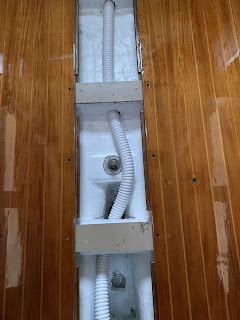As I worked through sanding and painting the bilges and grinding the limber holes, I decided to give some attention to the aft keelbolt area, which had washers bearing on fibreglass with no extra reinforcement. No real reason other than I had the area disassembled, had the required materials on hand, was in the process of painting, and it is intuitively a good idea.
The area in question
A carbon fibre and glass pad was made first, dead flat. This to be bedded into a dense epoxy/long-strand-glass/cabosil putty, with additional laminations of epoxy/biaxial stitch mat installed in situ. Photo taken while determining the location of the hole to be bored for the bolt.
The patient prepped.
The flat carbon/glass pad installed on top of the putty, still uncured, with the next laminations laid up on a sheet of waxed paper, awaiting installation, wet on wet for the best comformability and bond. The latter is made of several layers biaxial stitch-mat, each progressively smaller. This makes a lamination that tapers toward each edge. This makes sense structurally and finishes nicely. The thinking is explained further in another blog post.

The lamination inverted and carefully placed, edges smoothed, and waxed paper on top to assist in forming a smooth finish.
While we're at it might as well make a new plate/washer. Self-explanatory.
And the final result, epoxied and varnished cabin sole, new bilge pump hose, bolts re-bedded and torqued to spec.





















